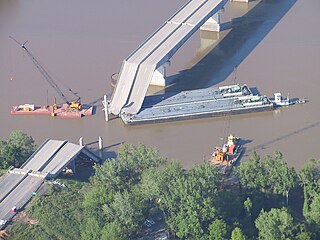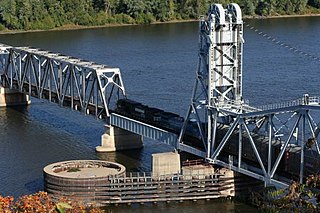
A pusher, pusher craft, pusher boat, pusher tug, or towboat, is a boat designed for pushing barges or car floats. In the United States, the industries that use these vessels refer to them as towboats. These vessels are characterized by a square bow and a shallow draft, and they typically have knees, which are large plates mounted to the bow for pushing barges of various heights. These boats usually operate on rivers and inland waterways. Multiple barges lashed together, or a boat and any barges lashed to it, are referred to as a tow and can have dozens of barges. Many of these vessels, especially the long-haul boats, include living quarters for the crew.

U.S. Route 82 is an east–west United States highway in the Southern United States. Created on July 1, 1931 across central Mississippi and southern Arkansas, US 82 eventually became a 1,625-mile-long (2,615 km) route extending from the White Sands of New Mexico to Georgia's Atlantic coast.

The Astoria–Megler Bridge is a steel cantilever through-truss bridge in the Pacific Northwest region of the United States that spans the lower Columbia River. It carries a section of U.S. Route 101 from Astoria, Oregon, to Point Ellice near Megler, Washington. Opened in 1966, it is the longest continuous truss bridge in North America.

The I-40 bridge disaster was a bridge collapse that occurred southeast of Webbers Falls, Oklahoma, United States at 7:45 a.m. on May 26, 2002. Freight barges being transported on the Arkansas River collided with a pier supporting the Interstate 40 road bridge crossing the river. The resulting failure of the supports caused a section of the bridge to collapse, killing 14 people and injuring another 11. The collision was determined to have resulted from the captain of the barges' towboat losing consciousness.

The Cooper River Bridges were a pair of cantilever truss bridges that carried traffic over the Cooper River in Charleston, South Carolina, United States. The first bridge opened in 1929, a second one opened in 1966 to relieve traffic congestion. The Grace Memorial Bridge was designed and constructed by a private company known as Cooper River Bridge, Inc, and the Pearman Bridge was designed by HNTB Corporation and constructed by SCDOT.

The Huey P. Long Bridge, located in Jefferson Parish, Louisiana, is a cantilevered steel through-truss bridge that carries a two-track railroad line over the Mississippi River at mile 106.1, with three lanes of US 90 on each side of the central tracks. It is several kilometers upriver from the city of New Orleans. The East Bank entrance is at Elmwood, Louisiana, and the West Bank at Bridge City.

The Fort Madison Toll Bridge is a tolled, double-decked swinging truss bridge over the Mississippi River that connects Fort Madison, Iowa, and unincorporated Niota, Illinois. A double-track railway occupies the lower deck of the bridge, while two lanes of road traffic are carried on the upper deck. The bridge is about 1 mile (1.6 km) long with a swing span of 525 feet (160 m), and was the longest and largest double-deck swing-span bridge in the world when constructed in 1927. It replaced an inadequate combination roadway/single-track bridge completed in 1887. The main river crossing consists of four 270-foot (82 m) Baltimore through truss spans and a swing span made of two equal arms, 266 feet (81 m) long. In 1999, it was listed in the National Register of Historic Places under the title, Fort Madison Bridge, ID number 99001035. It was also documented as survey number IA-62 by the Historic American Engineering Record, archived at the Library of Congress. Construction and photographic details were recorded at the time in Scientific American magazine.

The Wabasha–Nelson Bridge is a truss bridge that connects Wabasha, Minnesota with Nelson, Wisconsin, crossing the Mississippi River. The bridge has a street setup, with one lane for motor vehicles in each direction. It carries Minnesota State Highway 60 and WI 25.

The Natchez–Vidalia Bridge are two twin cantilever bridges carrying U.S. Route 84, and 425 across the Mississippi River between Vidalia, Louisiana and Natchez, Mississippi. It is the tallest bridge in Mississippi.

The Greenville Bridge, or the Jesse Brent Memorial Bridge, is a cable-stayed bridge over the Mississippi River, in the United States, carrying US 82 and US 278 between Refuge, Mississippi, and Shives, Arkansas. When it opened in 2010, it was the fourth-longest cable-stayed bridge in North America.

The Helena Bridge is a cantilever bridge carrying U.S. Route 49 across the Mississippi River between Helena, Arkansas and Lula, Mississippi.

The Memphis & Arkansas Bridge, also known as the Memphis–Arkansas Bridge or inaccurately as the Memphis–Arkansas Memorial Bridge, is a cantilevered through truss bridge carrying Interstate 55 across the Mississippi River between West Memphis, Arkansas and Memphis, Tennessee. Memphians refer to this bridge as the "Old Bridge" to distinguish it from the "New Bridge", or Hernando de Soto Bridge, upstream.

The Harahan Bridge is a cantilevered through truss bridge that carries two rail lines and a pedestrian bridge across the Mississippi River between West Memphis, Arkansas, and Memphis, Tennessee. The bridge is owned and operated by Union Pacific Railroad and is the second longest pedestrian/bicycle bridge in the United States. It was built with roadways cantilevered off the sides of the main structure for vehicles. These roadways are owned by the cities of Memphis, Tennessee, and Crittenden County, Arkansas, and were used from 1917–1949, until the Memphis & Arkansas Bridge opened 400 feet (120 m) south of the Harahan. The bridge was named in honor of railroad executive James Theodore Harahan, former president of the Illinois Central Railroad, who was killed in a railroad accident during the construction of the bridge. In February 2011, Union Pacific Railroad officials agreed to the idea of converting the 1917 roadways into a bicycle-pedestrian walkway across the river. In June 2012, Memphis was awarded a $14.9 million federal grant to build the walkway. The overall project was expected to cost $30 million, of which about $11 million was used for the Harahan Bridge portion. Construction was completed in 2016.

The Cairo Mississippi River Bridge is a steel truss through deck bridge carrying U.S. Route 60 and U.S. Route 62 across the Mississippi River. Located in the tri-state area of Illinois, Kentucky, and Missouri, it connects Cairo, Illinois at its northern terminus to Bird's Point, Missouri at its southern terminus. The bridge is currently closed for renovation until October 1, 2024. The bridge measures 5,175.5 feet in length with a main span of 700.9 feet and a width of 20 feet. At its apex, the bridge stands 114 feet above the river with a 675-foot (206-meter) navigation channel. In the years since the construction of the bridge, the town of Cairo has experienced an 81% population decline, the most dramatic decrease of any principal city in the United States. The bridges initially played a part in the town's demise as the ferry and railroad industries were severely impacted.

The Wabash Bridge carries one railroad track across the Mississippi River between Hannibal, Missouri, and Pike County, Illinois. Built by the Wabash Railroad, the bridge is today owned by the Norfolk Southern Railway.

The La Crosse Rail Bridge is a swing bridge that spans the Mississippi River between La Crescent, Minnesota and La Crosse, Wisconsin. The first bridge in this location initially was designed and ready to build by June 1876, and was completed in November 1876 by the Milwaukee and St. Paul Railway, a predecessor of the Chicago, Milwaukee, St. Paul and Pacific Railroad. It was later replaced in 1902. It is at the Western end of the Canadian Pacific Railway Tomah Subdivision. Amtrak's Empire Builder crosses this bridge.

State Road 2 is a former east–west state highway in the Arkansas Timberlands and Lower Arkansas Delta. The route was approximately 195 miles (314 km), and ran from US Route 67 (US 67) in Texarkana east to cross the Mississippi River near Lake Village, continuing as Mississippi Highway 10. On July 1, 1931, the route was entirely replaced by US Highway 82 (US 82) by the American Association of State Highway Officials (AASHTO). The route was maintained by the Arkansas Highway Department (AHD), now known as the Arkansas Department of Transportation (ArDOT).

Highway 144 is a designation for two state highways in Southeast Arkansas. One route of 7.82 miles (12.59 km) begins at Big Bayou Meto Use Area and runs east to US Highway 165 (US 165), Highway 1, and the Great River Road (GRR). A second route of 20.50 miles (32.99 km) begins at US 165 near Jerome and runs east through Lake Village to a levee near the Mississippi River. Both routes are maintained by the Arkansas Department of Transportation (ArDOT). While overlapping US 65/US 278 in Chicot County, the route is part of the Great River Road, a national scenic byway following the Mississippi River.




















